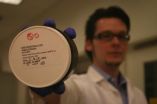Novel nano-structures to realize hydrogen's energy potential
Chemical engineers from the University of NSW in Sydney have demonstrated for the first time that a promising hydrogen storage material can release and reabsorb energy
2012-08-15
(Press-News.org) For the first time, engineers at the University of New South Wales have demonstrated that hydrogen can be released and reabsorbed from a promising storage material, overcoming a major hurdle to its use as an alternative fuel source.
Researchers from the Materials Energy Research Laboratory in nanoscale (MERLin) at UNSW have synthesised nanoparticles of a commonly overlooked chemical compound called sodium borohydride (NaBH4) and encased these inside nickel shells. Their unique nanostructure has demonstrated remarkable hydrogen storage properties.
"No one has ever tried to synthesise these particles at the nanoscale because they thought it was too difficult, and couldn't be done. We're the first to do so, and demonstrate that energy in the form of hydrogen can be stored with sodium borohydride at practical temperatures and pressures," says Dr Kondo-Francois Aguey-Zinsou from the School of Chemical Engineering at UNSW.
Considered a major a fuel of the future, able to bridge the gap between renewables and fossil fuels, hydrogen could be used to power buildings, portable electronics and vehicles – but this application hinges on practical storage technology.
Lightweight compounds known as borohydrides (including lithium and sodium compounds) are known to be effective storage materials but it was believed that once the energy was released it could not be reabsorbed – a critical limitation. This perceived "irreversibility" means there has been little focus on sodium borohydride.
However, the UNSW result published in the journal ACS Nano, demonstrates for the first time that reversibility is indeed possible using a borohydride material by itself and could herald significant advances in the design of novel hydrogen storage materials.
"By controlling the size and architecture of these structures we can tune their properties and make them reversible – this means they can release and reabsorb hydrogen," says Aguey-Zinsou, lead author on the paper. "We now have a way to tap into all these borohydride materials, which are particularly exciting for application on vehicles because of their high hydrogen storage capacity."
The researchers observed remarkable improvements in the thermodynamic and kinetic properties of their material. This means the chemical reactions needed to absorb and release hydrogen occurred faster than previously studied materials, and at significantly reduced temperatures – making possible applications far more practical.
In its bulk form, sodium borohydride requires temperatures above 550 degrees Celsius just to release hydrogen. Even on the nano-scale the improvements are minimal.However, with their core-shell nanostructure, the researchers saw initial energy release happening at just 50 °C, and significant release at 350 °C.
"The new materials that could be generated by this exciting strategy could provide practical solutions to meet many of the energy targets set by the US Department of Energy," says Aguey-Zinsou. "The key thing here is that we've opened the doorway."
INFORMATION: END
ELSE PRESS RELEASES FROM THIS DATE:
2012-08-15
The Pipe Nebula is a prime example of a dark nebula. Originally, astronomers believed these were areas in space where there were no stars. But it was later discovered that dark nebulae actually consist of clouds of interstellar dust so thick it can block out the light from the stars beyond. The Pipe Nebula appears silhouetted against the rich star clouds close to the centre of the Milky Way in the constellation of Ophiuchus (The Serpent Bearer).
Barnard 59 forms the mouthpiece of the Pipe Nebula [1] and is the subject of this new image from the Wide Field Imager on the ...
2012-08-15
An international team of researchers has found that certain bioactive components found in human milk are associated with a reduced risk of HIV transmission from an HIV infected mother to her breast-fed infant. Their study will be published in the August 15 online edition of American Journal of Clinical Nutrition.
"In developing countries, HIV-infected mothers are faced with the decision of whether or not to breastfeed their babies," said Lars Bode, PhD, assistant professor in the Department of Pediatrics at the University of California, San Diego School of Medicine. ...
2012-08-15
DURHAM, N.C. – Researchers at Duke University Medical Center may finally have discovered why people with sickle cell disease get milder cases of malaria than individuals who have normal red blood cells.
In a finding that has eluded scientists for years, Duke researchers discovered that genetic material in red blood cells may help alter parasite activity via a novel mechanism that alters parasite gene regulation.
"One of the most interesting findings in our study is that the human microRNA (very small units of genetic material) found in sickle red cells directly participate ...
2012-08-15
Melting over the Greenland ice sheet shattered the seasonal record on August 8 – a full four weeks before the close of the melting season, reports Marco Tedesco, assistant professor of Earth and atmospheric sciences at The City College of New York.
The melting season in Greenland usually lasts from June – when the first puddles of meltwater appear – to early-September, when temperatures cool. This year, cumulative melting in the first week in August had already exceeded the record of 2010, taken over a full season, according to Professor Tedesco's ongoing analysis. ...
2012-08-15
In our zest for cleanliness, have we permanently muddied our nation's waters?
A science team from Arizona State University, in collaboration with federal partners,
has completed the first statewide analysis of freshwater bodies in Minnesota, finding widespread evidence of the presence of active ingredients of personal care products in Minnesota lakes, streams and rivers.
These products are a billion dollar industry and can be found in antimicrobial soaps,
disinfectants, and sanitizers to scrub our hands and clean countertops. Hundreds of antimicrobial products are ...
2012-08-15
New research from New Zealand's University of Otago is casting doubt on a landmark US study that suggested infants as young as six months old possess an innate moral compass that allows them to evaluate individuals as 'good' or 'bad'.
The 2007 study by Yale University researchers provided the first evidence that 6- and 10-month-old infants could assess individuals based on their behaviour towards others, showing a preference for those who helped rather than hindered another individual.
Based on a series of experiments, researchers in the Department of Psychology at ...
2012-08-15
LOS ANGELES (Aug. 14, 2012) – An experimental immune-based therapy more than doubled median survival of patients diagnosed with the most aggressive malignant brain tumor, Cedars-Sinai Medical Center researchers reported in Cancer Immunology, Immunotherapy, published online Aug. 3.
Median survival in a Phase I clinical trial at Cedars-Sinai's Johnnie L. Cochran, Jr. Brain Tumor Center was 38.4 months, significantly longer than the typical 14.6-month survival of patients with newly diagnosed glioblastoma receiving standard therapy alone, which includes radiation and chemotherapy.
Median ...
2012-08-15
Long-term methadone treatment can cause changes in the brain, according to recent studies from the Norwegian Institute of Public Health. The results show that treatment may affect the nerve cells in the brain. The studies follow on from previous studies where methadone was seen to affect cognitive functioning, such as learning and memory.
Since it is difficult to perform controlled studies of methadone patients and unethical to attempt in healthy volunteers, rats were used in the studies. Previous research has shown that methadone can affect cognitive functioning in ...
2012-08-15
A sense of fairness is an important part of human behaviour, yet a research team involving Queen Mary, University of London (UK) found it did not evolve from our closest living relatives.
The study, published in the journal Biology Letters today (15 August) tested whether our great ape relatives, the chimpanzees and bonobos, have a sense of fairness like humans.
The scientists, involving Professor Keith Jensen, from Queen Mary's School of Biological and Chemical Sciences, put the apes through a series of ultimatum games.
One against the other, they had to choose ...
2012-08-15
Philadelphia, PA, August 15, 2012 – Depression takes a substantial toll on brain health. Brain imaging and post-mortem studies provide evidence that the wealth of connections in the brain are reduced in individuals with depression, with the result of impaired functional connections between key brain centers involved in mood regulation. Glial cells are one of the cell types that appear to be particularly reduced when analyzing post-mortem brain tissue from people who had depression. Glial cells support the growth and function of nerve cells and their connections.
Over ...
LAST 30 PRESS RELEASES:
[Press-News.org] Novel nano-structures to realize hydrogen's energy potential
Chemical engineers from the University of NSW in Sydney have demonstrated for the first time that a promising hydrogen storage material can release and reabsorb energy



